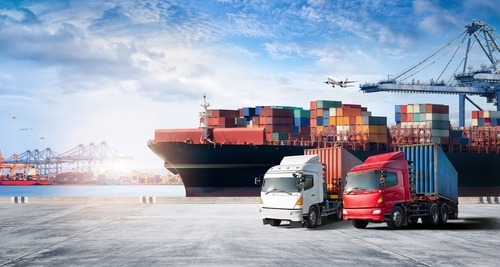Trading the Sharp Decline in Global Shipping Rates
International and domestic shipping rates have reverted to pre-pandemic levels in recent months, as overall cargo volume has declined

The COVID-19 pandemic served as a major disruption to most “normal” daily operations. And the outbreak of war in Eastern Europe in the spring of 2022 only served to exacerbate those disruptions, especially for people and companies located in close proximity to the conflict.
Going forward, it will be interesting to see what constitutes the “new normal.”
But, one aspect of the global economy that seems to have reverted to its previous state is the global shipping network. As of December 2022, the cost to ship a container overseas is now on par with the levels observed back in 2019.
For example, the rate to ship a 40-foot container from Shanghai to Los Angeles is now around $2,300. That’s down roughly 80% from the rate observed at the start of 2022, when it was above $11,000/container.
The huge drop in container shipping costs was confirmed recently during the Q3 earnings call for Euroseas (ESEA), a European-based oceanic freight operator.
On that call, the CEO of Euroseas—Aristides Pittas—said of recent market trends, “Containership rates reached all-time highs for most vessel segments in spring of 2022, [and] stayed near those levels through August, but since the beginning of September 2022 have started declining, dropping almost 80% through the beginning of November.”
Data from other niches of the global shipping industry mirror the trends observed in the containership sector.
Case in point, the Baltic Dry Index (BDI) is currently trading at about 1,300, which is only slightly above the levels observed in December 2019. The BDI measures changes in the cost of transporting bulk commodities (coal, iron ore, grain, etc.) across a variety of transoceanic routes. As highlighted in the chart below, the BDI has been trending lower since early summer.
Baltic Dry Index (1-year chart)
Source: MarineVesselTraffic.com
Data published by transcontinental trucking companies has also revealed a reversion to pre-pandemic pricing levels. For example, the cost to ship goods via semi-trucks in the United States has fallen dramatically in recent months. According to DAT Solutions, the average rate per mile to ship goods via semi-truck in the U.S. is currently hovering at about $2.37, which marks the lowest level in this metric since the fall of 2020.
Interestingly, it appears that two key factors have contributed to the industry-wide decline in shipping rates. The first relates to a decline in global consumption (reduced demand), which appears to stem from a slowdown in the global economy. That means overall cargo numbers are declining.
This factor has in turn allowed for healing in the overall supply chain, which had been crippled by the COVID-19 pandemic. A healthier supply chain has also contributed to lower prices.
Bottlenecks popped up at many of the world’s largest ports during the pandemic as a result of rolling economic lockdowns. And due to those snags in the system, many of the world’s containerships were forced to anchor outside the port, waiting to unload.
That situation ultimately led to a shortage of shipping containers, as most of the world’s supply was either sitting on anchored ships, or stacked up at ports, waiting for domestic delivery.
However, due to a decline in demand, and an overall easing of the supply chain, the world is now facing the opposite problem: too many containers. Fresh data shows that many of the world’s container depots, storage areas for empty containers, are filling up.
Based on current projections, the situation is expected to get worse before it gets better. Christian Roeloffs, CEO of the container logistics company Container XChange commented recently, “There is just not enough depot space to accommodate all the containers, and with the further release of container inventory into the market, there will be added pressure on depots in the coming months.”
An overabundance of containers obviously represents a vastly different market than one in which containers are in short supply, and speaks to the broader pricing environment.
The big question going forward is whether the current global economic slowdown will be a brief affair, or whether the world is facing a more protracted economic downturn. In the latter case, freighting companies—whether transcontinental or transoceanic—will likely have to tighten their belts to avoid financial losses.
Along those lines, FedEx Corp (FDX) recently announced it would furlough an unspecified number of workers in its freight division due to downward pressure on shipping volumes.
For investors and traders active in the shipping sector, there may be fresh opportunities that stem from the aforementioned decline in shipping rates. To track and trade the global shipping sector, add the following companies to your watchlists—featuring both transoceanic and transcontinental operators.
Marine Shipping Stocks
- A.P. Moller-Maersk (AMKBY)
- Danaos Corporation (DAC)
- Eagle Bulk Shipping (EGLE)
- EuroSeas (ESEA)
- Genco Shipping & Trading Limited (GNK)
- Golar LNG Limited (GLNG)
- Golden Ocean Group Limited (GOGL)
- Global Ship Lease (GSL)
- International Seaways (INSW)
- Kirby Corporation (KEX)
- Matson (MATX)
- Safe Bulkers (SB)
- SFL Corporation (SFL)
- Star Bulk Carriers (SBLK)
- ZIM Integrated Shipping Services (ZIM)
Trucking and Logistics Stocks
- ArcBest Corp (ARCB)
- C.H. Robinson Worldwide (CHRW)
- Covenant Logistics (CVLG)
- J.B. Hunt (JBHT)
- Knight-Swift Transportation (KNX)
- Landstar System (LSTR)
- Marten Transport (MRTN)
- Navistar International (NAV)
- Old Dominion Freight (ODFL)
- Paccar Inc. (PCAR)
- Patriot Transportation (PATI)
- Ryder (R)
- Schneider National (SNDR)
- TFI International (TFI)
- United Parcel Service (UPS)
- Werner Enterprises (WERN)
- Yellow Corp (YELL)
To follow everything moving the markets during the remainder of 2022—including the global shipping sector—check out TASTYTRADE LIVE, weekdays from 7 a.m. to 4 p.m. CDT.
Sage Anderson is a pseudonym. He’s an experienced trader of equity derivatives and has managed volatility-based portfolios as a former prop trading firm employee. He’s not an employee of Luckbox, tastytrade or any affiliated companies. Readers can direct questions about this blog or other trading-related subjects, to support@luckboxmagazine.com.



















